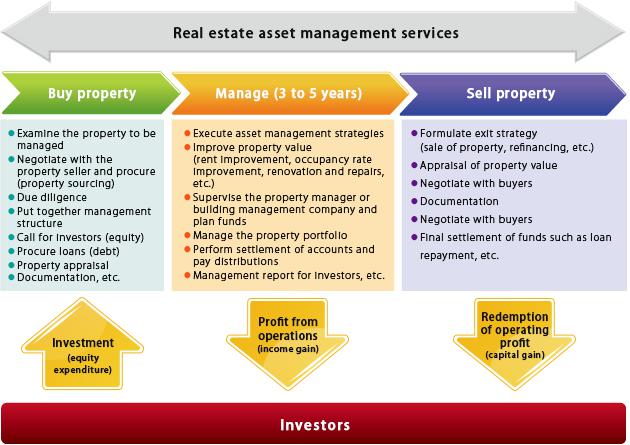
Real estate asset management seeks to reduce risk while maximising returns on investments. Asset managers consider the entire life cycle of an asset, and give investors firsthand information about factors that impact its performance. They also devise and execute economic strategy for investors.
The role of asset manager has grown as institutional ownership has replaced individual ownership. A typical property manager is an experienced professional with the asset class that he or she oversees. This includes market and portfolio optimization, data analysis, forecasting, as well as forecasting. Real estate investment presents many challenges and requires an understanding of tax laws.
A business plan is developed to manage property assets and strategic asset improvements are made to increase their value. Asset managers keep a complete inventory of the property including rents, operating expenses, and any rights. These are essential factors in determining the best way to structure leases to draw tenants. A great property manager is key to a successful investment.

Business plans typically include a market study to determine local demand, an assessment and forecast of supply, a cost estimation for property improvements, and evaluation of management possibilities. Once the business plan has been developed, it can be used to generate steady cash flow and increase property value over time.
Real estate is more complicated than capital markets. It takes time to purchase and manage properties. This means that asset managers are able to leverage their professional investor expertise to help invests in real estate. Some asset managers conduct stress tests on investor portfolios.
It does not matter whether you are an active investor or a large one, it is vital to have a professional asset manager. The right property manager can provide you with peace of mind by monitoring your investments' performance and helping you reach your goals.
Asset managers should have a physical presence to support their investments. They can keep investors informed, provide data tracking and make strategic investments that will help them grow their portfolio. They can also advise investors about the best strategies to increase the value of their investments. Using asset managers' services can increase the returns on your investment by up to 30 percent.

Although the practice of asset management is not new, it has evolved over the past 50 years. A skilled asset manager will increase your portfolio's value while also minimizing expenses. He or she can also offer you firsthand knowledge of trends and factors that affect the real estate market.
Asset managers manage market research, budgeting capital improvements, leasing, and other operations. Many times, they are responsible for managing a portfolio that includes eight to twelve properties. An asset manager can focus on one type of property or a specific region depending on how large your portfolio is.
FAQ
Where did handymen originate?
Although there are many handymen in the United States, almost all of them were not originally contractors. Many started out as tradesmen, learning the skills through apprenticeships. These individuals are highly skilled and possess a wealth knowledge which can make them valuable assets to any business.
Is it worth the extra cost of professional handyman work?
It all depends on the type project that you wish to have completed. A professional handyman service will be helpful if you have a complicated project such as an office remodel.
What can a handyman do to install new fixtures and appliances?
You can always hire a handyman to help with these kinds of projects. Make sure you know exactly what appliance or fixture you need to be installed beforehand.
What is the distinction between a handyman & a carpenter
You can hire a handyman to do a variety projects like plumbing, electrical installations, painting, drywall repair and cabinet making. Carpenters specialize in woodworking. They can build cabinets walls, doors windows, doors, stairs, decks roofs fences sheds, and many other things.
Are handymen insured?
Yes! Yes. Many insurance companies cover liability claims that exceed $1 million for bodily injuries and property damage. This means that your insurance company will compensate you for any damage caused by an accident during the project.
Can a handyman fix my leaky faucets?
While a handyman might be capable of minor repairs and not needing the proper training, he or she will be able to take on larger projects such as wiring up a house, installing custom cabinets, or rewiring it. However, a handyman is capable of doing minor home improvement projects.
How many hours is it typical to complete a DIY project of this nature?
On average, DIY projects take between 2 and 4 hours. The project's complexity and difficulty will impact the length.
Statistics
- More than 20% of homes in America have outdoor living spaces, including decks and patios. (mrhandyman.com)
- According to the U.S. Bureau of Labor Statistics, in May 2020, there are 1,357,630 handymen employed in the U.S.. (angi.com)
- An estimate was that in 2003, the market for home maintenance and repair spending was up 14% 2001 to 2003. (en.wikipedia.org)
- Our handyman services for seniors are provided by professional senior helpers who have been serving the community for over 20 years with 98% customer satisfaction. (cantatahomeservices.org)
- “Once the pandemic hit, that number fell to about 20%.” (inquirer.com)
External Links
How To
How do I replace a cracked window?
It is one of the most commonly performed home improvements. Repairing damage to glass within your home is the task. Repairs should take about 30 minutes in this situation. You could end up causing more damage to your house if you don't know the best way to replace a damaged pane. This article will give you some helpful tips for replacing broken windows.
First, take the old glasses out of their frames
First, remove all screws that hold the glass in place. Next, take out the lock at top center of the window frame's bottom section. Next, lift the window upwards so it isn’t attached to sill plates (the metal bars below the floor). Next, remove any remaining screws using a pry instrument until they are loosen. After the panes have been removed, you should clean them thoroughly.
Second step: Clean your new glass
Use a dry towel or paper towel to clean the glass. Use a spray bottle with water and alcohol to clean any debris that has gotten under the glass.
Third Step: Reinstall the replacement glass
Reattach the window panes into the frames. Begin by pressing down on the outermost pane's lower edge with a screwdriver. Gently push your pane back into its opening. Then move to the next pane, pushing it firmly against the previous pane before reattaching it. Continue inserting the panes till the window is complete. Use a silicone caulk gun to seal the space where the panes meet.
Fourth Step: Repair the area damaged
When installing the new glass, inspect the area around the hole to determine whether any additional repairs are needed. Two small pieces of wood should be placed along the edges of each hole if the crack is near the corner. These wooden blocks will provide strength for the window, as well as acting as spacers during the expansion or contraction of the weatherproofing.
Fiveth step: Seal the repair area
After the glass has been replaced, apply a bead of silicone caulking to the perimeter edges of the window frame. This will create a good seal between the glass and the surrounding wallboard. You can find silicone caulking in hardware stores and online. It is important to match the color of the walls with silicone caulking.
Finally, let the caulking cure overnight. After the caulking has dried completely, do not disturb it. If you don't wait long enough, you could cause the caulking to crack when you remove it.